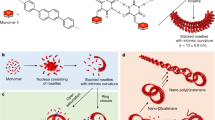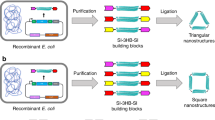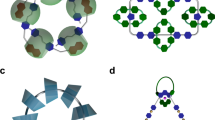Abstract
Mechanically interlocked molecules (MIMs), such as rotaxanes and catenanes, have captured the attention of chemists both from a synthetic perspective and because of their role as simple prototypes of molecular machines. Although examples exist in nature, most synthetic MIMs are made from artificial building blocks and assembled in organic solvents. The synthesis of MIMs from natural biomolecules remains highly challenging. Here, we report on a synthesis strategy for interlocked molecules solely made from peptides, that is, mechanically interlocked peptides (MIPs). Fully peptidic, cysteine-decorated building blocks were self-assembled in water to generate disulfide-bonded dynamic combinatorial libraries consisting of multiple different rotaxanes, catenanes and daisy chains as well as more exotic structures. Detailed NMR spectroscopy and mass spectrometry characterization of a [2]catenane comprising two peptide macrocycles revealed that this structure has rich conformational dynamics reminiscent of protein folding. Thus, MIPs can serve as a bridge between fully synthetic MIMs and those found in nature.

This is a preview of subscription content, access via your institution
Access options
Access Nature and 54 other Nature Portfolio journals
Get Nature+, our best-value online-access subscription
$29.99 / 30 days
cancel any time
Subscribe to this journal
Receive 12 print issues and online access
$259.00 per year
only $21.58 per issue
Buy this article
- Purchase on Springer Link
- Instant access to full article PDF
Prices may be subject to local taxes which are calculated during checkout





Similar content being viewed by others
Data availability
The coordinates for [2]catenane 3-2H have been deposited in the Protein Data Bank (PDB) with accession code 7LL7. The coordinates have also been deposited in the Biological Magnetic Resonance Data Bank (BMRB), the accession number is 30852. All data, including the mass spectra for all compounds, are present in the main text or the Supplementary Information. Due to the large data file size, the raw MS data underlying the figures will be provided upon request.
References
Siegel, J. S. Driving the formation of molecular knots. Science 338, 752–753 (2012).
Liang, C. & Mislow, K. Knots in proteins. J. Am. Chem. Soc. 116, 11189–11190 (1994).
Mallam, A. L., Morris, E. R. & Jackson, S. E. Exploring knotting mechanisms in protein folding. Proc. Natl Acad. Sci. USA 105, 18740–18745 (2008).
Dabrowski-Tumanski, P. & Sulkowska, J. I. Topological knots and links in proteins. Proc. Natl Acad. Sci. USA 114, 3415–3420 (2017).
Stoddart, J. F. Mechanically interlocked molecules (MIMs)—molecular shuttles, switches, and machines (Nobel lecture). Angew. Chem. Int. Ed. 56, 11094–11125 (2017).
Sauvage, J.-P. From chemical topology to molecular machines (Nobel lecture). Angew. Chem. Int. Ed. 56, 11080–11093 (2017).
Stoddart, J. F. & Bruns, C. J. The Nature of the Mechanical Bond: From Molecules to Machines (Wiley, 2016).
Browne, W. R. & Feringa, B. L. Making molecular machines work. Nat. Nanotechnol. 1, 25–35 (2006).
Zhang, L., Marcos, V. & Leigh, D. A. Molecular machines with bio-inspired mechanisms. Proc. Natl Acad. Sci. USA 115, 9397–9404 (2018).
Erbas-Cakmak, S. et al. Rotary and linear molecular motors driven by pulses of a chemical fuel. Science 358, 340–343 (2017).
Cheng, C. et al. An artificial molecular pump. Nat. Nanotechnol. 10, 547–553 (2015).
Chen, S. et al. An artificial molecular shuttle operates in lipid bilayers for ion transport. J. Am. Chem. Soc. 140, 17992–17998 (2018).
Lewandowski, B. et al. Sequence-specific peptide synthesis by an artificial small-molecule machine. Science 339, 189–193 (2013).
Schalley, C. A., Vögtle, F. & Dötz, K. H. Templates in Chemistry I (Springer, 2004).
Crowley, J. D., Goldup, S. M., Lee, A. L., Leigh, D. A. & McBurney, R. T. Active metal template synthesis of rotaxanes, catenanes and molecular shuttles. Chem. Soc. Rev. 38, 1530–1541 (2009).
Ferguson, A. L. et al. An experimental and computational investigation of spontaneous lasso formation in microcin J25. Biophys. J. 99, 3056–3065 (2010).
Steemers, L., Wanner, M. J., Lutz, M., Hiemstra, H. & van Maarseveen, J. H. Synthesis of spiro quasi[1]catenanes and quasi[1]rotaxanes via a templated backfolding strategy. Nat. Commun. 8, 15392 (2017).
Martin-Gomez, H. & Tulla-Puche, J. Lasso peptides: chemical approaches and structural elucidation. Org. Biomol. Chem. 16, 5065–5080 (2018).
Waliczek, M. et al. Attempting to synthesize lasso peptides using high pressure. PLoS ONE 15, e0234901 (2020).
Soudy, R., Wang, L. & Kaur, K. Synthetic peptides derived from the sequence of a lasso peptide microcin J25 show antibacterial activity. Bioorg. Med. Chem. 20, 1794–1800 (2012).
Moretto, A., Crisma, M., Formaggio, F. & Toniolo, C. Peptide-based rotaxanes and catenanes: an emerging class of supramolecular chemistry systems. Biomol. Concepts 3, 183–192 (2012).
Yan, L. Z. & Dawson, P. E. Design and synthesis of a protein catenane. Angew. Chem. Int. Ed. 40, 3625 (2001).
Blankenship, J. W. & Dawson, P. E. Threading a peptide through a peptide: protein loops, rotaxanes, and knots. Protein Sci. 16, 1249–1256 (2007).
Da, X. D. & Zhang, W. B. Active template synthesis of protein heterocatenanes. Angew. Chem. Int. Ed. 58, 11097–11104 (2019).
Liu, Y. et al. Cellular synthesis and X-ray crystal structure of a designed protein heterocatenane. Angew. Chem. Int. Ed. 59, 16122–16127 (2020).
Liu, Y. et al. Lasso proteins: modular design, cellular synthesis, and topological transformation. Angew. Chem. Int. Ed. 59, 19153–19161 (2020).
Zhai, C., Schreiber, C. L., Padilla-Coley, S., Oliver, A. G. & Smith, B. D. Fluorescent self-threaded peptide probes for biological imaging. Angew. Chem. Int. Ed. 59, 23740–23747 (2020).
Saito, F. & Bode, J. W. Synthesis and stabilities of peptide-based [1]rotaxanes: molecular grafting onto lasso peptide scaffolds. Chem. Sci. 8, 2878–2884 (2017).
Aucagne, V., Leigh, D. A., Lock, J. S. & Thomson, A. R. Rotaxanes of cyclic peptides. J. Am. Chem. Soc. 128, 1784–1785 (2006).
Young, M. J., Akien, G. R. & Evans, N. H. An amide hydrogen bond templated [1]rotaxane displaying a peptide motif – demonstrating an expedient route to synthetic mimics of lasso peptides. Org. Biomol. Chem. 18, 5203–5209 (2020).
Leigh, D. A., Murphy, A., Smart, J. P. & Slawin, A. M. Z. Glycylglycine rotaxanes—the hydrogen bond directed assembly of synthetic peptide rotaxanes. Angew. Chem. Int. Ed. 36, 728–732 (1997).
Sawada, T., Yamagami, M., Ohara, K., Yamaguchi, K. & Fujita, M. Peptide [4]catenane by folding and assembly. Angew. Chem. Int. Ed. 55, 4519–4522 (2016).
Sawada, T., Inomata, Y., Shimokawa, K. & Fujita, M. A metal–peptide capsule by multiple ring threading. Nat. Commun. 10, 5687 (2019).
Lam, R. T. et al. Amplification of acetylcholine-binding catenanes from dynamic combinatorial libraries. Science 308, 667–669 (2005).
Schulte, T. R. et al. A new mechanically-interlocked [Pd2L4] cage motif by dimerization of two peptide-based lemniscates. Angew. Chem. Int. Ed. 59, 22489–22493 (2020).
Chung, M. K., White, P. S., Lee, S. J., Waters, M. L. & Gagné, M. R. Self-assembled multi-component catenanes: structural insights into an adaptable class of molecular receptors and [2]-catenanes. J. Am. Chem. Soc. 134, 11415–11429 (2012).
Chung, M. K., Lee, S. J., Waters, M. L. & Gagné, M. R. Self-assembled multi-component catenanes: the effect of multivalency and cooperativity on structure and stability. J. Am. Chem. Soc. 134, 11430–11443 (2012).
Inomata, Y., Sawada, T. & Fujita, M. Metal-peptide torus knots from flexible short peptides. Chem 6, 294–303 (2020).
Song, Y. W. et al. Effects of turn-structure on folding and entanglement in artificial molecular overhand knots. Chem. Sci. 12, 1826–1833 (2021).
Allen, C. D. & Link, A. J. Self-assembly of catenanes from lasso peptides. J. Am. Chem. Soc. 138, 14214–14217 (2016).
Corbett, P. T. et al. Dynamic combinatorial chemistry. Chem. Rev. 106, 3652–3711 (2006).
Furusho, Y. et al. Dynamic covalent approach to [2]- and [3]rotaxanes by utilizing a reversible thiol–disulfide interchange reaction. Chem. Eur. J. 9, 2895–2903 (2003).
Lu, S. et al. Directed disulfide pairing and folding of peptides for the de novo development of multicyclic peptide libraries. J. Am. Chem. Soc. 142, 16285–16291 (2020).
Otto, S. & Kubik, S. Dynamic combinatorial optimization of a neutral receptor that binds inorganic anions in aqueous solution. J. Am. Chem. Soc. 125, 7804–7805 (2003).
Ponnuswamy, N., Cougnon, F. B., Clough, J. M., Pantos, G. D. & Sanders, J. K. M. Discovery of an organic trefoil knot. Science 338, 783–785 (2012).
Otto, S., Furlan, R. L. & Sanders, J. K. M. Selection and amplification of hosts from dynamic combinatorial libraries of macrocyclic disulfides. Science 297, 590–593 (2002).
Carnall, J. M. et al. Mechanosensitive self-replication driven by self-organization. Science 327, 1502–1506 (2010).
Bartolec, B., Altay, M. & Otto, S. Template-promoted self-replication in dynamic combinatorial libraries made from a simple building block. Chem. Commun. 54, 13096–13098 (2018).
Liu, B. et al. Complex molecules that fold like proteins can emerge spontaneously. J. Am. Chem. Soc. 141, 1685–1689 (2019).
de Veer, S. J., Kan, M. W. & Craik, D. J. Cyclotides: from structure to function. Chem. Rev. 119, 12375–12421 (2019).
Hegemann, J. D., Zimmermann, M., Xie, X. & Marahiel, M. A. Lasso peptides: an intriguing class of bacterial natural products. Acc. Chem. Res. 48, 1909–1919 (2015).
Bayro, M. J. et al. Structure of antibacterial peptide microcin J25: a 21-residue lariat protoknot. J. Am. Chem. Soc. 125, 12382–12383 (2003).
Wilson, K. A. et al. Structure of microcin J25, a peptide inhibitor of bacterial RNA polymerase, is a lassoed tail. J. Am. Chem. Soc. 125, 12475–12483 (2003).
Pan, S. J. & Link, A. J. Sequence diversity in the lasso peptide framework: discovery of functional microcin J25 variants with multiple amino acid substitutions. J. Am. Chem. Soc. 133, 5016–5023 (2011).
Pavlova, O., Mukhopadhyay, J., Sineva, E., Ebright, R. H. & Severinov, K. Systematic structure-activity analysis of microcin J25. J. Biol. Chem. 283, 25589–25595 (2008).
Ducasse, R. et al. Sequence determinants governing the topology and biological activity of a lasso peptide, microcin J25. ChemBioChem 13, 371–380 (2012).
Zong, C., Wu, M. J., Qin, J. Z. & Link, A. J. Lasso peptide benenodin-1 is a thermally actuated [1]rotaxane switch. J. Am. Chem. Soc. 139, 10403–10409 (2017).
Blond, A. et al. Thermolysin-linearized microcin J25 retains the structured core of the native macrocyclic peptide and displays antimicrobial activity. Eur. J. Biochem. 269, 6212–6222 (2002).
Rosengren, K. J. et al. Structure of thermolysin cleaved microcin J25: extreme stability of a two-chain antimicrobial peptide devoid of covalent links. Biochemistry 43, 4696–4702 (2004).
Atcher, J. & Alfonso, I. The effect of DMSO in the aqueous thiol–disulphide dynamic covalent chemistry of model pseudopeptides. RSC Adv. 3, 25605–25608 (2013).
Romuald, C., Cazals, G., Enjalbal, C. & Coutrot, F. Straightforward synthesis of a double-lasso macrocycle from a nonsymmetrical [c2]daisy chain. Org. Lett. 15, 184–187 (2013).
Safont-Sempere, M. M., Fernández, G. & Würthner, F. Self-sorting phenomena in complex supramolecular systems. Chem. Rev. 111, 5784–5814 (2011).
Wasserman, E. The preparation of interlocking rings: a catenane. J. Am. Chem. Soc. 82, 4433–4434 (1960).
Schill, G. & Lüttringhaus, A. The preparation of catena compounds by directed synthesis. Angew. Chem. Int. Ed. Engl. 3, 546–547 (1964).
Allen, C. D. et al. Thermal unthreading of the lasso peptides astexin-2 and astexin-3. ACS Chem. Biol. 11, 3043–3051 (2016).
Roberts, D. A., Pilgrim, B. S. & Nitschke, J. R. Covalent post-assembly modification in metallosupramolecular chemistry. Chem. Soc. Rev. 47, 626–644 (2018).
Romano, M. et al. Structural basis for natural product selection and export by bacterial ABC transporters. ACS Chem. Biol. 13, 1598–1609 (2018).
Wedemeyer, W. J., Welker, E. & Scheraga, H. A. Proline cis–trans isomerization and protein folding. Biochemistry 41, 14637–14644 (2002).
Trainor, K., Palumbo, J. A., MacKenzie, D. W. S. & Meiering, E. M. Temperature dependence of NMR chemical shifts: tracking and statistical analysis. Protein Sci. 29, 306–314 (2020).
Dietrich-Buchecker, C. O., Sauvage, J.-P. & Kintzinger, J.-P. Une nouvelle famille de molecules: les metallo-catenanes. Tetrahedron Lett. 24, 5095–5098 (1983).
Ashton, P. R. et al. A [2]catenane made to order. Angew. Chem. Int. Ed. 28, 1396–1399 (1989).
Jamieson, E. M. G., Modicom, F. & Goldup, S. M. Chirality in rotaxanes and catenanes. Chem. Soc. Rev. 47, 5266–5311 (2018).
Acknowledgements
We thank I. Pelczer and H. Elashal for support with the NMR experiments. This work was supported by NIH grant GM107036 to A.J.L. H.V.S. gratefully acknowledges support by the Deutsche Forschungsgemeinschaft (DFG Research Fellowship 427725459).
Author information
Authors and Affiliations
Contributions
H.V.S. and A.J.L. conceived the project idea. H.V.S. and Y.Z. carried out the molecular cloning experiments and peptide purification. H.V.S. carried out the MS and NMR analyses. H.V.S. and A.J.L. analysed the data. H.V.S. and A.J.L. acquired funding. H.V.S wrote the first draft of the manuscript, and it was edited by A.J.L. All the authors contributed to and approved the final version of the manuscript.
Corresponding author
Ethics declarations
Competing interests
The authors declare no competing interests.
Additional information
Peer review information Nature Chemistry thanks Jan van Maarseveen and the other, anonymous, reviewer(s) for their contribution to the peer review of this work.
Publisher’s note Springer Nature remains neutral with regard to jurisdictional claims in published maps and institutional affiliations.
Supplementary information
Supplementary Information
Supplementary Figs. 1–72, Tables 1–6 and Methods
Rights and permissions
About this article
Cite this article
Schröder, H.V., Zhang, Y. & Link, A.J. Dynamic covalent self-assembly of mechanically interlocked molecules solely made from peptides. Nat. Chem. 13, 850–857 (2021). https://doi.org/10.1038/s41557-021-00770-7
Received:
Accepted:
Published:
Issue Date:
DOI: https://doi.org/10.1038/s41557-021-00770-7
This article is cited by
-
Water-stable boroxine structure with dynamic covalent bonds
Nature Communications (2024)
-
Quick photofabrication of functional nanospheres from de novo designed peptides for NIR fluorescence and MR imaging
Nano Research (2023)
-
Detachable and hierarchical assemblies for recyclable and highly efficient oil-fouling removal
Nano Research (2023)
-
Mechanically interlocked networks cross-linked by a molecular necklace
Nature Communications (2022)
-
The occurrence of ansamers in the synthesis of cyclic peptides
Nature Communications (2022)



